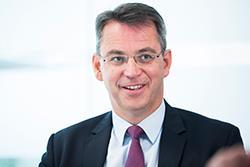Anyone that works, lives or simply visits London will testify that our capital is changing rapidly, possibly more rapidly than at any time in its history.

London, once a low-rise city, has grown upwards over the past 10 years with a new generation of tall buildings reinventing the old skyline.
The changes at street level are equally dynamic too, where delivery of new public space sits alongside new street finishes providing a clean, safe and welcoming environment. Our hosting of the 2012 Olympics really did act as a catalyst for sustainable change. Crucially, innovative thinking on how these spaces integrate with each other has created a series of new vibrant ‘pockets’. But it is the structural changes to London that intrigue me the most. Traditionally, central London has been ‘bookended’ by the City to the east and the West End, with the River Thames providing the demarcation between the north and south. It has always been assumed that London’s evolution would be on its east-west axis, and regeneration concentrated north of the river with the south a forgotten hinterland.
Not so! What we see today is a ‘hub and spoke’ city, with the delivery of new above- and below-ground infrastructure, most notably Thameslink and Crossrail. This has led to large-scale development around London’s principal transport nodes such as Paddington, King’s Cross, Liverpool Street and London Bridge. Waterloo, Euston and Vauxhall will all follow.
The redrawing of the London map is happening before our very eyes and although the city continues to expand east and west, it is the ‘central core’ where the changes are most dynamic.
In the north, the rebirth of King’s Cross, steered by Argent, has created a world class campus. At London Bridge, Irvine Sellar’s vision to create a business district south of the river is now a reality, with The Shard the catalyst for London’s emerging ‘media quarter’. The South Bank market, formerly concentrated at London Bridge and Bankside is expanding west, with the redevelopment of Battersea Power Station and the creation of the Nine Elms district around the new US Embassy.
The area in the middle, christened ‘Midtown’, is also undergoing a major renaissance. Having worked in Midtown for the majority of my 30-year career, I am surprised more than most by the persistent misperception that this is an overspill location for the City and West End.
Crossrail has proved to be a catalyst for further change. When the station at Farringdon is fully operational in 2018, Transport for London predicts it will be one of the most accessible places on the planet.
Midtown is no longer a homogenous product; We see it as seven distinct villages nestling between Tottenham Court Road and Farringdon. With Sir Terry Farrell’s help, The Midtown Business Club is engaging with stakeholders on how these various areas can be integrated through better public space and amenities.
The diversity of the Centre of London environment is now reflected in the occupier base. Midtown has traditionally been the home of London’s legal community, with the presence of the law courts and the Law Society making it an attractive location for lawyers. They have an increasingly diverse mix of neighbours drawn from the DAMIT sector - design, advertising (plus marketing and PR), media, internet and technology (and telecoms) companies, London’s real growth sector.
I am sure that many of us are now surprised to see ‘suits and jeans’ side-by-side geographically, but this diversification is not specific to Midtown. New occupational ‘villages’ are breaking out all over central London. Who would have thought 10 years ago that DAMIT companies would lease more space in London than their financial services counterparts?
For years, the focus has been east and west. Looking ahead, my view is that our capital will spin just as much on its north-south axis.
Alistair Subba Row is senior partner at Farebrother






























No comments yet